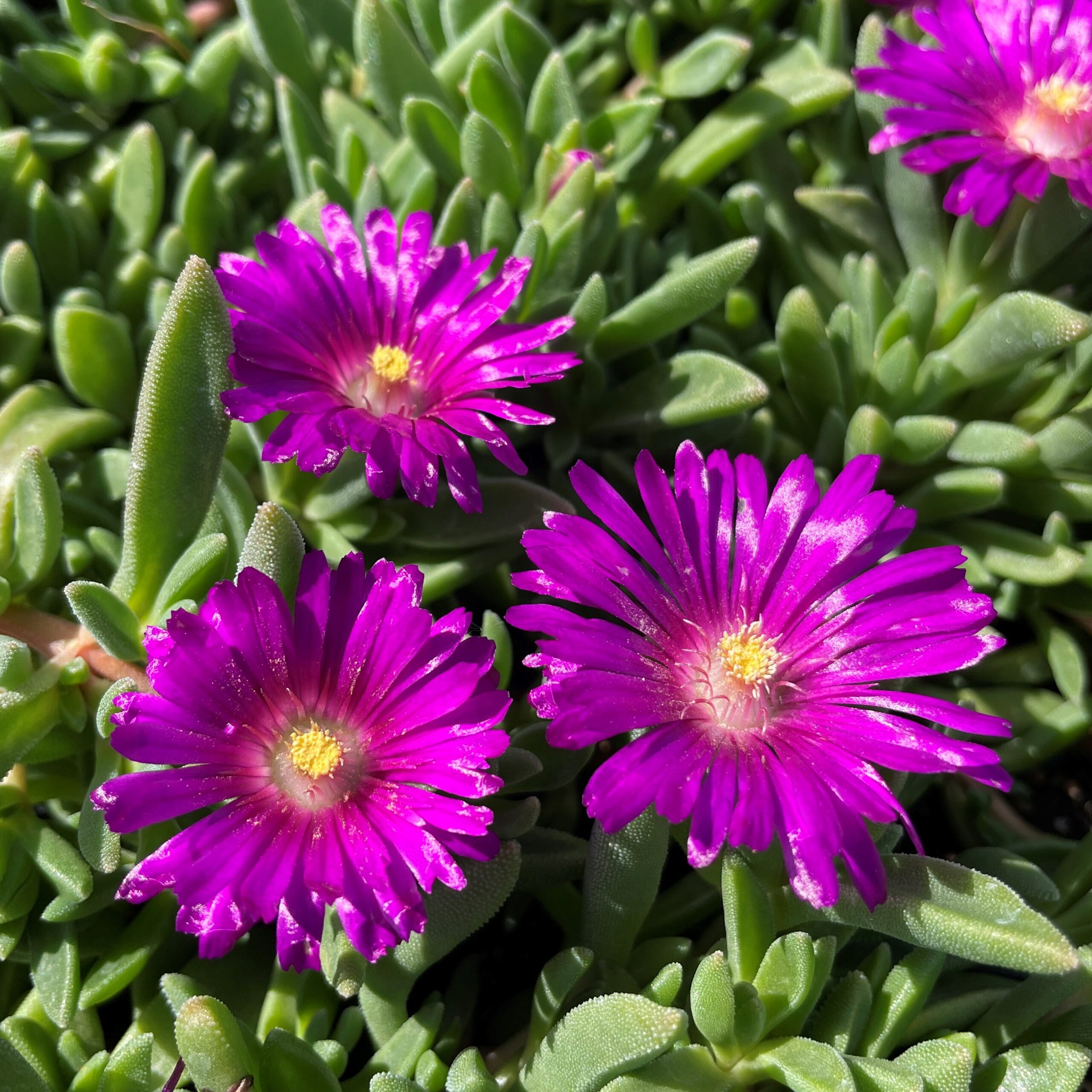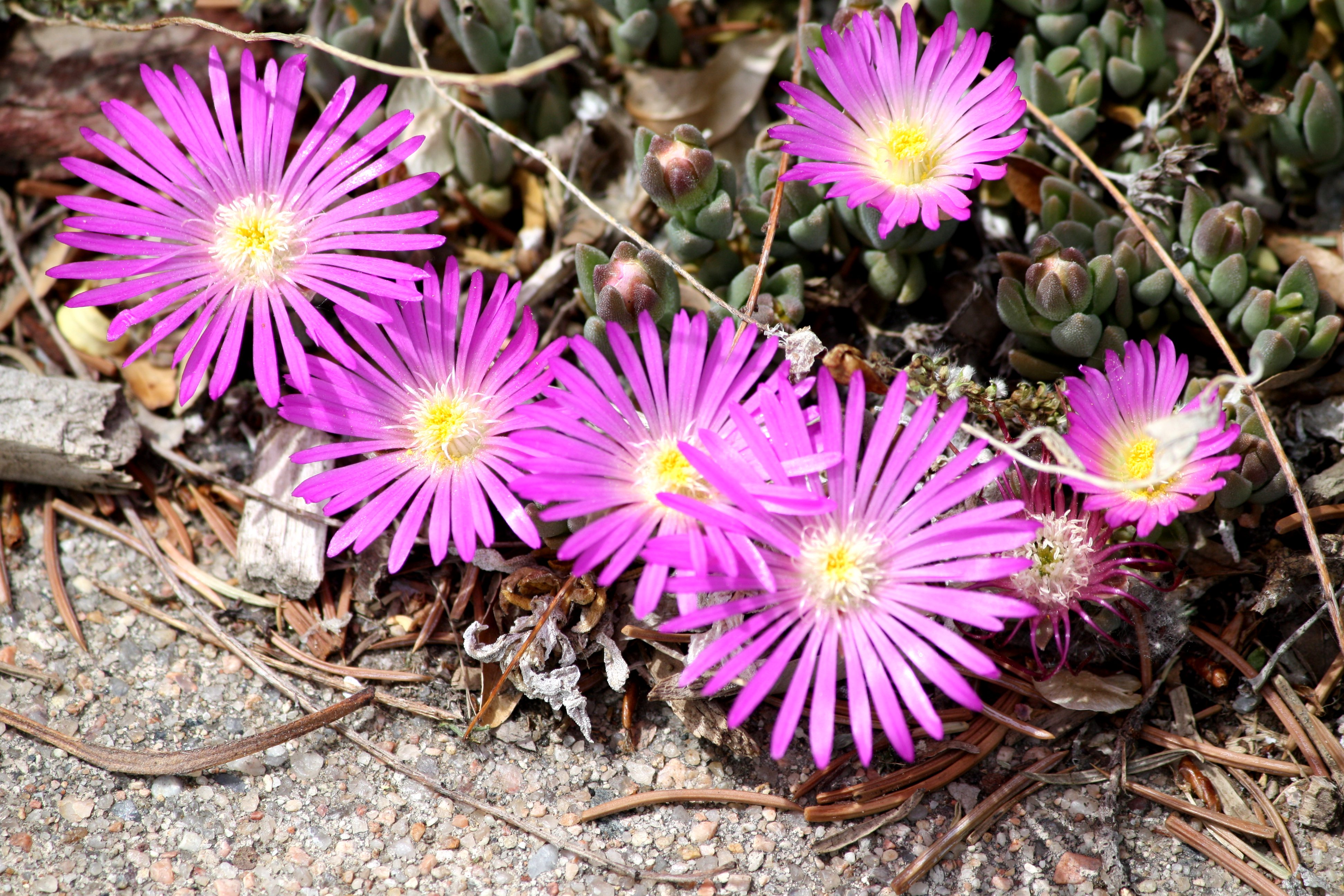Ice plant pink flowers, with their captivating allure, beckon us into a realm of botanical beauty. These remarkable plants, adorned with delicate pink blossoms, offer a vibrant spectacle that transforms landscapes and captivates hearts.
Their unique morphology, comprising fleshy leaves, trailing stems, and shallow roots, sets them apart from the ordinary. The star-shaped pink flowers, blooming profusely during the summer months, add a touch of whimsy to any garden.
Botanical Description of Ice Plant with Pink Flowers

The ice plant with pink flowers, botanically known as Mesembryanthemum crystallinum, is a fascinating succulent plant belonging to the Aizoaceae family. It captivates with its captivating pink blooms, unique morphology, and salt-tolerant nature.
Growth Habit and Morphology
This ice plant is a low-growing, sprawling perennial that forms dense mats. Its fleshy stems, tinged with a reddish hue, extend along the ground, rooting at the nodes to form new plants. The plant’s size varies depending on growing conditions, typically reaching a height of 4-8 inches and spreading up to 2-3 feet wide.
Leaves
The ice plant’s leaves are succulent and cylindrical, resembling tiny fingers. They are arranged in opposite pairs along the stems. The leaves are covered in numerous tiny, glistening hairs that give the plant its characteristic “icy” appearance. These hairs serve as water reservoirs, enabling the plant to withstand drought conditions.
Flowers
The ice plant with pink flowers produces abundant blooms that adorn the plant from late spring to early fall. The flowers are solitary, daisy-like, and borne on short stalks. Each flower consists of numerous delicate petals that range in color from pale to vibrant pink. The flowers typically measure about 1-2 inches in diameter and open during the day, attracting a variety of pollinators.
Stems
The stems of the ice plant are succulent and slightly woody at the base. They are reddish in color and grow in a sprawling manner, forming a dense mat. The stems are covered in the same tiny, glistening hairs as the leaves, giving them a similar “icy” appearance.
Roots
The ice plant’s root system is fibrous and shallow. The roots are primarily responsible for anchoring the plant in the soil and absorbing water and nutrients. They are well-adapted to the plant’s natural habitat, which often consists of sandy or saline soils.
Cultivation and Care Requirements
Ice plants with pink flowers thrive in well-drained soil that is slightly acidic to alkaline, with a pH range of 5.5 to 8.0. They prefer full sun exposure but can also tolerate partial shade. Watering should be infrequent, as these plants are drought-tolerant and can survive on rainfall alone in most areas.
Planting and Spacing
When planting ice plants with pink flowers, space them approximately 12 to 18 inches apart to allow for proper air circulation and growth. Dig a hole twice the width of the root ball and just as deep. Place the plant in the hole and backfill with soil, gently tamping down to remove any air pockets. Water thoroughly after planting.
Maintenance
To maintain healthy ice plants with pink flowers, remove any dead or damaged leaves or stems. Fertilize lightly in the spring with a balanced fertilizer. Deadheading spent blooms will encourage new growth and flowering.
Challenges and Considerations
Ice plants with pink flowers are generally low-maintenance plants but may be susceptible to mealybugs, aphids, and scale insects. If these pests become a problem, treat them with an insecticidal soap or horticultural oil. Additionally, these plants may develop root rot in poorly drained soil, so ensure proper drainage before planting.
Landscape Applications and Uses: Ice Plant Pink Flowers

Ice plants with pink flowers are versatile landscaping elements, offering a range of applications to enhance outdoor spaces. Their low-growing habit and drought tolerance make them ideal for various scenarios, from groundcovers to borders and rock gardens.
Groundcovers
As groundcovers, ice plants with pink flowers create a dense, carpet-like effect that suppresses weeds and adds visual interest to slopes, pathways, and other areas where traditional lawn grass may not thrive. Their vibrant blooms provide a splash of color, complementing surrounding plants and adding a touch of whimsy.
Borders
When planted along borders, ice plants with pink flowers create a distinct and eye-catching edging that defines garden beds and walkways. Their compact size allows for precise shaping, creating formal or informal borders that enhance the overall design of outdoor spaces.
Rock Gardens, Ice plant pink flowers
In rock gardens, ice plants with pink flowers thrive among boulders and other rocky elements, adding a touch of softness and color to these often harsh environments. Their succulent leaves and drought tolerance make them well-suited for these conditions, providing a vibrant contrast to the surrounding rocks.
Creative Applications
Beyond these traditional uses, ice plants with pink flowers can also be incorporated into more creative and innovative landscaping designs. They can be planted in hanging baskets or containers to create vertical accents, or used as a colorful filler in mixed borders. Their ability to tolerate saline conditions makes them suitable for coastal gardens, adding a touch of coastal flair to outdoor spaces.